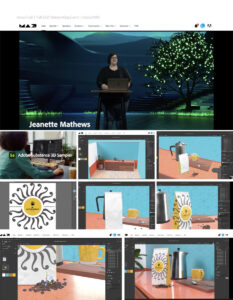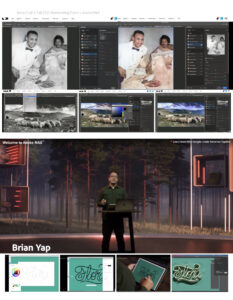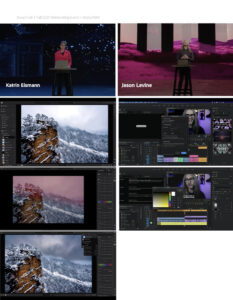Going back to week 7, October 19th I signed up for AdobeMAX. It was easy because I have a student account with Adobe. The event took place over three days, the 26-28th of October. This year it was free to attend.
Check out this link to learn more about the 2021 MAX speakers and events: www.adobe.com/max.html
October 26th from noon – 1:30 I watched the AdobeMAX Keynote. To be honest I was unaware of Adobe’s full capability and I am impressed by the attention to detail and their ability to listen to artists’ needs and translate their own wants in a platform that is accessible to creatives.
I believe this year’s AdobeMAX purpose was to educate and inform of the artistic capabilities Adobe Sensei has to offer: https://www.adobe.com/sensei.html. Short version an AI that is meant to help data analysis, marketers, creatives, advertisers and businesses.
If you should take away anything from this week’s post, it’s that the MAX Keynote highlighted the importance of these three quotes:
“Creativity is a team sport”
“Creativity is inspiration and community”
“Creativity is a catalyst for positive change”
The creators at Adobe want their programs to Enable Connected Creativity while Unleashing Creative Potential by Empowering Creative Careers.
They also highlight Create Tomorrow. Together. And that Creativity and Organization is equal to Impact.
An Adobe employee by the name of Terry White demoed the new Photoshop features. For example he took a landscape image and changed the seasons with a click of a button. The setting is called Neural Filters. He even demonstrated the updated precision of masking an object using a candle. Isolating a single object allows for easier color change of selected masks. But my favorite demo was also a click of a button. White took an old black and white image of his parents and made it color! Neural Filters has an option called Colorize. Selecting it will auto calculate what It believes the original image would look like. Then you can apply traditional Photoshop features like saturation to the image. Now I plan to try it. I am thinking of taking my old family photos and applying this technique. Possibly for a family Christmas gift this year. What I like about this new Photoshop feature is that it works on ANY black and white image. Once you colorize an image you can click on the small top right image and use the focus points color picker to change the color of any selection. White changed the shy to a darker blue.
Similarly as I continued watching a woman named Katrin Eismann explained the two new features to Lightroom, select subject and select sky. I have used the application before although not in a couple of semesters. It was great to know it’s now possible to isolate and colorize just like photoshop! She demoed on both a person and landscape image to show how the program can now recognize detailed images.
As I continued watching Brian Yap introduced Illustrator’s three new features:
- Illustrator is now on the web
- 3D Tools and Materials
- Vectorize on Ipad
I own an ipad however thus far I have never used Illustrator on it. Only Fresco, Capture and Spark on the ipad. His demonstration took a flat 2 word, that Yap previously drew and transformed it into a 3D word. He was able to adjust the line curvature of the word by holding onto the anchor points like in the desktop versions as well as indesign.
Something I took note of while watching was the way Adobe takes into consideration collaboration. There is now a copy link button that generates a url to be shared and viewed on an internet browser. This is extremely useful for those that would like to see the progress, or completed work and do not own Adobe applications.
I also found the presenters ranged in diversity and age. This made me happy because it reiterates inclusiveness and program friendliness for all ages.
AdobeMax instructor Jason Levine shared a new feature in Premiere Pro called create transcript that will automatically transcribe audio files giving you the timecode of each speaker 1, 2 etc. This is really important for interviews, captions and voiceovers when editing because you can pinpoint the exact sequence of words. You can also apply color, and change the font of the captions.
Adobe Substance is a sampler program. This one really caught my attention because I took a 3D course using C4D (Cinema 4D) and loved it! The downside for me was having to learn a new whole new interface in a short amount of time. However I noticed Substance’s interface has similar characteristics to C4D. Like selecting material and pre-made models. I am excited for this program because I am comfortable and familiar with both Adobes and C4D Interface. Jeanette Matthews demonstration was a scenario I thought would be helpful for packaging design, graphic designers and interior designers. Matthews was able to create a 3D scene of a coffee bag and place a logo on the model inside of the scene. She was able to manipulate the coffee beans using the Z plane. 
As a side note all programs are getting updated to Cloud Canvas. This will allow collaboration of assets. I really like this idea. I think it will be extremely useful for group and remote working. I felt this feature was similar to Canva’s presentation feature www.canva.com/presentations/.






